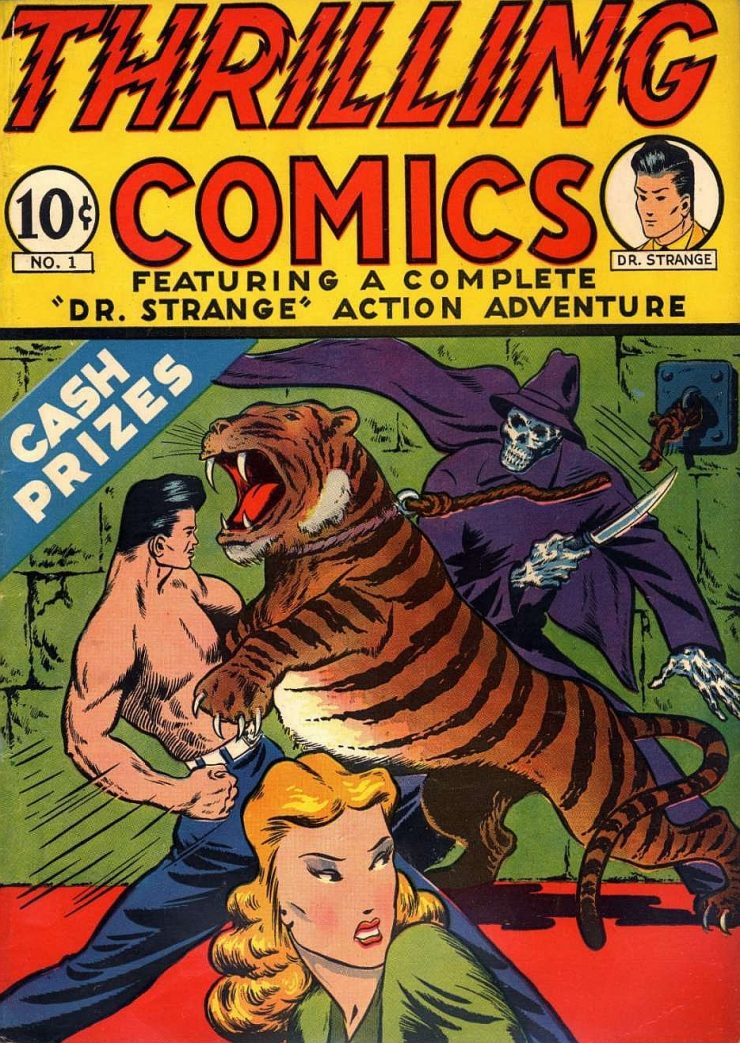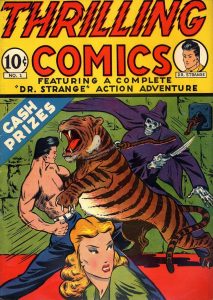 Since late May, we’ve primarily been exploring the pulp magazines of the Thrilling Group on the PulpFest home page. We’ve discussed the Standard sports pulps, western hero pulps, thrilling detectives, and the pulp heroes of the thirties and the forties. We’ve even found time to explore the lives and careers of Standard’s managing editor Leo Margulies and his assistant Mort Weisinger, prolific author Norman Daniels, equally prolific cover artist Rudolph Belarski, and more. Today, we will turn our attention to the Standard Comics line.
Since late May, we’ve primarily been exploring the pulp magazines of the Thrilling Group on the PulpFest home page. We’ve discussed the Standard sports pulps, western hero pulps, thrilling detectives, and the pulp heroes of the thirties and the forties. We’ve even found time to explore the lives and careers of Standard’s managing editor Leo Margulies and his assistant Mort Weisinger, prolific author Norman Daniels, equally prolific cover artist Rudolph Belarski, and more. Today, we will turn our attention to the Standard Comics line.
Ned Pines was primarily a pulp publisher with nearly four-thousand issues produced from 1931-1958, along with RANCH ROMANCES through 1971. However, Standard was also a second-tier comics firm from 1940 through 1959, with the circulation of the company’s comic books being somewhat limited on the West Coast. When they started hunting for them, comic book collectors found the Standard Comics to be much scarcer than pulps from Standard, especially given the firm’s prolific publication of science fiction and western pulps.
The firm’s costumed heroes were published only from 1940 through 1949, then made no appearances anywhere–except in fanzines–until a few AC reprints began popping up in the 1980s. Not counting westerns, science-fiction, magicians and jungle characters, Standard/Better/Nedor/Four Star/Pines/Visual Editions published only seventeen strips with costumed characters, most of them beginning during the first half of the 1940s. The only two names commonly recognized today are The Black Terror and The Fighting Yank. Therefore, as colorful as they were, the Standard heroes were far less known among Golden Age comic book collectors than were the super heroes from the likes of top-tier publishers DC, Timely, Fawcett, and Quality.
The company’s flagship character was ostensibly Doc Strange, who appeared in 88 stories beginning with THRILLING COMICS #1, dated February 1940, and running through #64, dated February 1948, and in the anthology title AMERICA’S BEST COMICS #1-23 and #27. Created by writer Richard Hughes, later the editor of the American Comics Group, and artist Alexander Kostuke, Doc Strange gained his powers from a magic elixir and was basically a super-powered Doc Savage. He soon began to resemble a weight-lifter in t-shirt and khaki pants. Doc never had his own title, but he was popular enough to hang around longer than most superheroes of the early forties, lasting almost to the end of the decade.
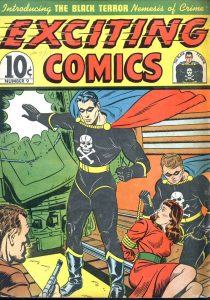 The real flagship, of course, became the colorful Black Terror, who debuted in EXCITING COMICS #9, dated May 1941, running through the last issue, #69, dated September 1949. Along with Tim, the teen partner he acquired, he was essentially a Batman knockoff and gained his powers through drugs — fitting because he was a pharmacist in civilian life. Unlike other publishers, Standard almost never used recurring villains, instead presenting the most generic of all generic super-hero stories. Also created by Hughes, as well as artist Don Gabrielson, The Black Terror was one of two Standard super heroes with his own title, running in #1-27 from 1942 through 1949. He also appeared in all 31 issues of AMERICA’S BEST COMICS, concurrent with his own title, for a total of 174 stories. All three of the comics that ran The Black Terror were canceled in 1949, and a few years later, the company largely departed the comic book market.
The real flagship, of course, became the colorful Black Terror, who debuted in EXCITING COMICS #9, dated May 1941, running through the last issue, #69, dated September 1949. Along with Tim, the teen partner he acquired, he was essentially a Batman knockoff and gained his powers through drugs — fitting because he was a pharmacist in civilian life. Unlike other publishers, Standard almost never used recurring villains, instead presenting the most generic of all generic super-hero stories. Also created by Hughes, as well as artist Don Gabrielson, The Black Terror was one of two Standard super heroes with his own title, running in #1-27 from 1942 through 1949. He also appeared in all 31 issues of AMERICA’S BEST COMICS, concurrent with his own title, for a total of 174 stories. All three of the comics that ran The Black Terror were canceled in 1949, and a few years later, the company largely departed the comic book market.
The other Standard character with his own title, The Fighting Yank, first appeared in STARTLING COMICS #10, dated September 1941. His adventures ran through STARTLING #49, dated Jan. 1948, along with FIGHTING YANK #1-29 and AMERICA’S BEST COMICS # 9, 11 and #13-25, for a total of 141 stories. A supernaturally created character, he was Standard’s answer to Timely’s Captain America and the many other mainstream Golden Age patriotic heroes. Likewise created by Hughes, along with artist Jon Blummer, the Yank was in “real life” Bruce Carter III, who had an identical ancestor — also named Bruce Carter — in the War for Independence. In times of crisis, the earlier Bruce would manifest himself in spirit form, and help out. It was the Revolutionary War Bruce who showed the World War II Bruce where to find a magic cloak able to protect him from harm and impart super strength. In addition to this green cloak, Bruce III’s Fighting Yank outfit included several 18th century fashion motifs, such as a tri-corner hat and square buckles, and a modern-style American flag on his chest. The series ended in 1949.
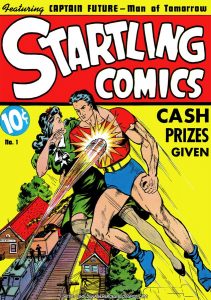 Standard’s other primary super heroes were Captain Future and Pyroman. Even though he had the same name as an existing Standard pulp hero, Captain Future resembled Superman and Captain Marvel. The character’s adventures ran from STARTLING COMICS #1, dated June 1940, through #40, dated July 1946. He also appeared in AMERICA’S BEST COMICS #1-3, 5 and 22, for 45 stories. The Captain was created by Pines editor Mort Weisinger, whose contribution seems to have been suggesting a hero who would have adventures under that name. Although the author is not known, the original Captain Future story was drawn by Kin Platt, who later co-created Supermouse, the first ongoing funny-animal superhero in comics.
Standard’s other primary super heroes were Captain Future and Pyroman. Even though he had the same name as an existing Standard pulp hero, Captain Future resembled Superman and Captain Marvel. The character’s adventures ran from STARTLING COMICS #1, dated June 1940, through #40, dated July 1946. He also appeared in AMERICA’S BEST COMICS #1-3, 5 and 22, for 45 stories. The Captain was created by Pines editor Mort Weisinger, whose contribution seems to have been suggesting a hero who would have adventures under that name. Although the author is not known, the original Captain Future story was drawn by Kin Platt, who later co-created Supermouse, the first ongoing funny-animal superhero in comics.
After scientist Andrew Bryant bathes himself in a mixture of gamma and infrared radiation, he can fly, emit bolts of energy from his hands, and perform prodigious feats of strength. Calling himself Captain Future, he wasn’t invulnerable and needed to be recharged from time to time. So he usually kept his radiation machine relatively handy. Although featured on the covers of the first nine issues of STARTLING COMICS, Captain Future was demoted to the back pages of the comic book following the introduction of The Fighting Yank in the tenth issue of the comic magazine.
Pyroman, a quasi-Human Torch with electrical powers, ran in STARTLING COMICS #18-26, 28-43 and in most issues of AMERICA’S BEST COMICS for a total of 43 stories. Created by an unknown writer and artist Jack Binder, Pyroman never had his own title, but did take the cover away from Fighting Yank in December, 1942, when his origin story appeared in STARTLING #18. Dick Martin had been a student of electrical engineering before being framed for arson. Sentenced to die in the electric chair, he got super-powered instead. Pyroman’s powers weren’t exactly flame-based, like The Human Torch’s. Instead, he was crackling with electricity, which he could hurl at his foes in the form of lightning bolts or form into a sort of force field. The character stuck around in STARTLING COMICS until 1947 when he was replaced by Lance Lewis, Space Detective.
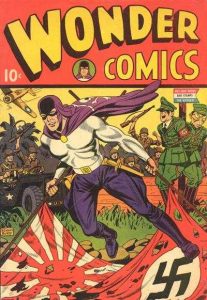 There were five other patriotic strips — Standard rivaled Timely for the most involvement in World War II by its super heroes. These were The American Eagle (34 stories, mostly in EXCITING), The American Crusader (22 stories, mostly in THRILLING), The Liberator (22 stories, mostly in EXCITING), The Four Comrades (a kid group who appeared only in World War II era issues of STARTLING) and The Grim Reaper (19 stories, all but two in WONDER COMICS #1-17).
There were five other patriotic strips — Standard rivaled Timely for the most involvement in World War II by its super heroes. These were The American Eagle (34 stories, mostly in EXCITING), The American Crusader (22 stories, mostly in THRILLING), The Liberator (22 stories, mostly in EXCITING), The Four Comrades (a kid group who appeared only in World War II era issues of STARTLING) and The Grim Reaper (19 stories, all but two in WONDER COMICS #1-17).
Standard had two early non-powered costume heroes — The Mask (only in EXCITING #1-20) and The Woman in Red (primarily in THRILLING). The Mask was the comic book version of The Black Bat, a pulp hero created by writer Norman Daniels for Standard’s BLACK BOOK DETECTIVE. Due to the resemblance of the character to Batman, Standard decided not to do a Black Bat comic series; instead it introduce The Mask, a series based on The Black Bat, but with the names changed. Later, a version of The Phantom Detective from the pulps appeared in most issues of THRILLING #53-70. The other noteworthy non-powered costume hero was Miss Masque, who appeared in sixteen stories in four titles, beginning with EXCITING #51 (Sept. 1946). The Scarab and The Cavalier also made a handful of appearances, but were strictly back-of-the-book characters.
Wonderman, a science-fictional super-powered character, debuted in the short-lived MYSTERY COMICS #1-4 (all 1944) and continued in WONDER COMICS #9-20, along with two stories in the giant COMPLETE BOOK OF COMICS AND FUNNIES (a 1944 one-shot). William F. Wise sub-published several comics for Standard during the era of wartime paper restrictions, including MYSTERY COMICS and two giant square bound one-shot titles in 1944.
Not counting the William F. Wise issues, Standard published only seven titles with costumed heroes. All were at least reasonably successful, including the twenty issues of WONDER COMICS from 1944-1948. The cover art, almost entirely by Alex Schomburg, doubtless had much to do with selling the comics, as most of the interior art was unremarkable. All titles ran bi-monthly or quarterly during most of the 1940s, with a short run of monthly issues for THRILLING, STARTLING, and EXCITING until paper rationing took hold.
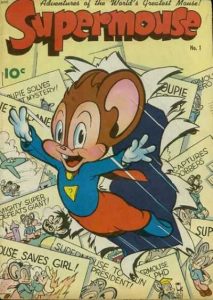 The only super heroes Standard published in the 1950s were mighty mice — the original World War II creation Supermouse, who ran through 1958, and Paul Terry’s Mighty Mouse. Standard acquired the license from St. John in the mid-1950s.
The only super heroes Standard published in the 1950s were mighty mice — the original World War II creation Supermouse, who ran through 1958, and Paul Terry’s Mighty Mouse. Standard acquired the license from St. John in the mid-1950s.
As part of its celebration of the Thrilling Group, PulpFest 2015 is proud to welcome Altus Press publisher and 2012 Munsey Award winner Matt Moring; 1979 Lamont Award winner and author of “The Wild Adventures of Doc Savage and Tarzan” Will Murray; pop culture expert and 2014 Inkpot Award winner Michelle Nolan; and popular culture Professor Garyn G. Roberts, who was awarded the Munsey in 2013, for a presentation entitled “Thrilling Heroes of Standard’s Pulps and Comics.” Scheduled for Friday evening, August 14th, at 10:40 PM, it will examine the evolution of the Standard hero in both pulp magazines and comic books. Thrilling’s heroes of the detective and western genres will be dissected on Thursday, August 13th.
Our discussion of Standard’s heroes began on Friday, June 19th, to call attention to this “Thrilling Presentation!!!” You can read our previous posts about the Thrilling pulp heroes of the thirties and forties by visiting pulpcon.org.
(Doc Strange, a super-powered Doc Savage, headlined the first issue of THRILLING COMICS, dated February 1940, and featuring cover artwork drawn by Alexander Kostuk.
The Black Terror was introduced in the ninth issue of EXCITING COMICS, dated May 1941. The front cover was drawn by Elmer Wexler. The character was created by writer Richard Hughes and artist Alexander Kostuke. The Black Terror was one of two Standard super heroes with his own title. The other was The Fighting Yank, likewise created by Hughes, along with artist Jon Blummer.
That’s the comic book Captain Future on the cover of STARTLING COMICS #1, dated June 1940. The cover artist was Kin Platt, who also drew the first Captain Future comic book story. A character who resembled Superman and Captain Marvel, the comic book version of Captain Future was nothing like the character found in the pulps, created by Edmond Hamilton.
Created by writer Richard Hughes and artist Al Camy, The Grim Reaper was one of a seeming army of non-superpowered masked mystery men who fought crime and the Axis during the forties using only their wits, fists, and, in the case of The Grim Reaper, two .45 automatic pistols, knives, swords, and occasionally machine-guns. Alex Schomburg was the cover artist featured on the first issue of WONDER COMICS, illustrating The Grim Reaper story that headed the issue. Debuting in FIGHTING YANK #7, dated February 1944, The Grim Reaper had to wait until the second issue of WONDER COMICS to have his origin story told.
Ned Pines was one of many pulp magazine publishers who got into comic books the minute he saw what success DC Comics was having with Superman. Like most, he entered the field with a bunch of anthology titles anchored by super heroes. He started diversifying the minute it began to look like the public might be getting tired of that genre. In 1942 and 1943, he introduced a couple of humor titles for kids, HAPPY COMICS and COO COO COMICS. It was in the first issue of the latter, dated October, 1942, that Supermouse made his debut. Supermouse went on to become one of the most successful funny animal superheroes to come out of comic books. Although COO COO fell by the wayside in 1952, Supermouse had gotten his own comic in 1948 and kept at it until Fall 1958, about a year before Pines completely dropped his line of comic books. Among the writers and artists to work on the character were Dan Gordon (creator of The Flintstones), Richard Hughes (creator of Herbie), Gene Fawcette (who worked for Quality Comics, Dell and many other publishers), and Milton Stein (who worked as an assistant animator for Fleischer in the 1940s). The cover art for SUPERMOUSE #1, dated December 1948, was drawn by Carl Wessler.
Many thanks to Michelle Nolan, Don Markstein’s TOONOPEDIA, Comic Book +, and Comic Vine for their help with this article.)

